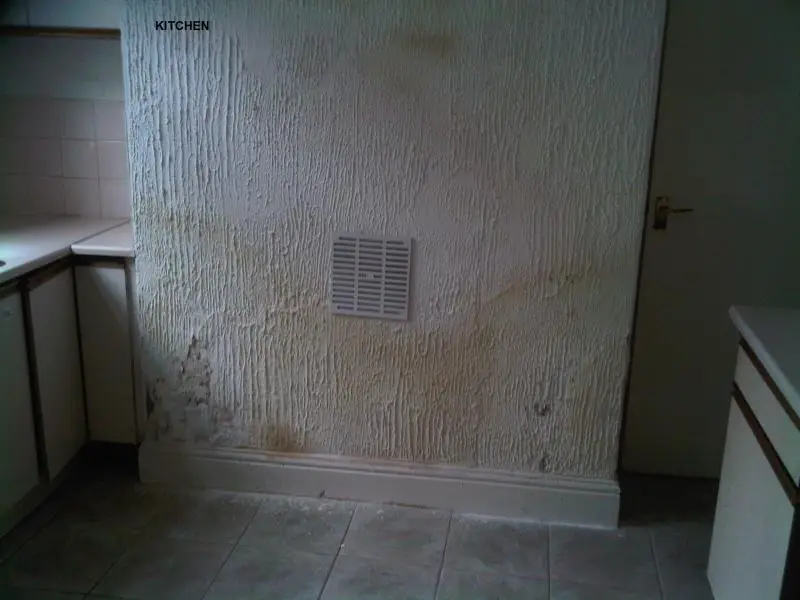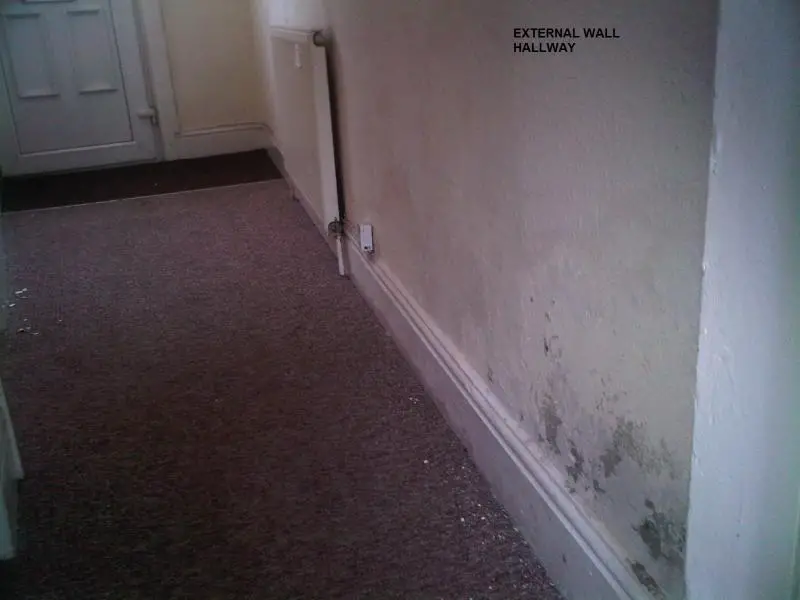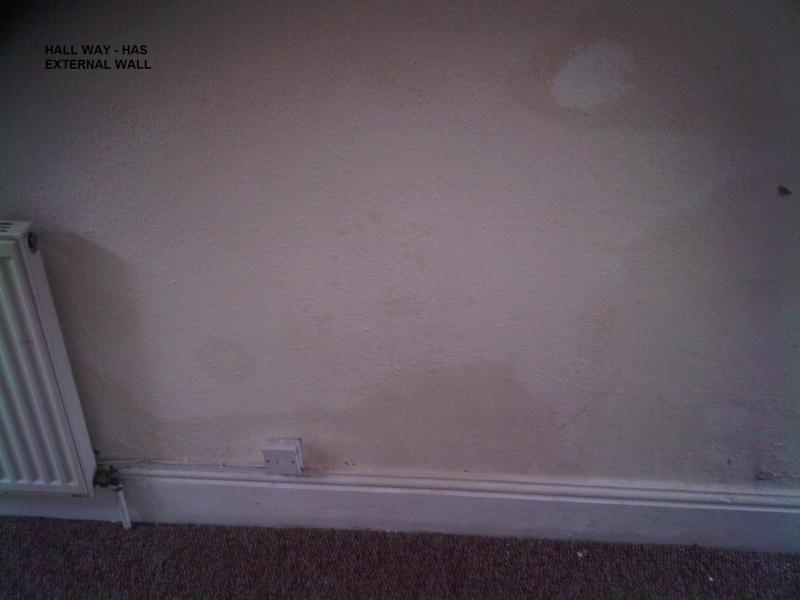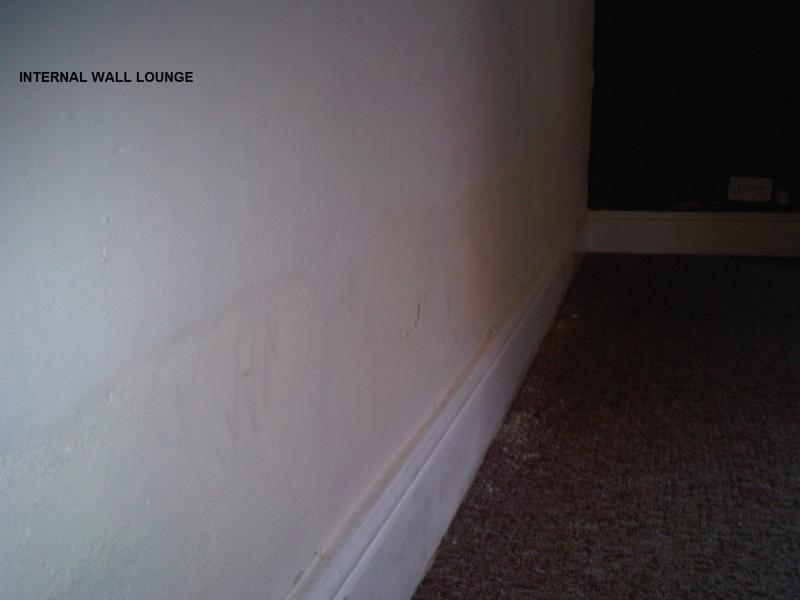You are using an out of date browser. It may not display this or other websites correctly.
You should upgrade or use an alternative browser.
You should upgrade or use an alternative browser.
Damp ? Whats happing to this house?
- Thread starter ibby
- Start date
Sponsored Links
SORRY - alittle slowCan't see anything.
Sponsored Links
- Joined
- 12 Jul 2012
- Messages
- 21
- Reaction score
- 0
- Country

rising damp normally only goes up to 1.2M high (above ground level) by capilary action... anything higher than that and it's most likely another cause i.e. breach of the cavity, leaking downcomer, defective pointing etc...
It's difficult to tell from the pics as there is no scale...
It's difficult to tell from the pics as there is no scale...
rising damp normally only goes up to 1.2M high (above ground level) by capilary action... anything higher than that and it's most likely another cause i.e. breach of the cavity, leaking downcomer, defective pointing etc...
It's difficult to tell from the pics as there is no scale...
The damp patches are around 0.6 meters in height.
The internal wall has a storage cellar underneath.
The wall looks dry to me.
I cant see any crystal or salt like deposits.
The external hallway damp is happeing because a garage is next door with a gap, I am sure the water is running down the side and hanging around at the bottom.
What do you mean, breach of cavity?
- Joined
- 12 Jul 2012
- Messages
- 21
- Reaction score
- 0
- Country

The only way you can accurately determine the moisture content of a wall is by using a meter. If you are going to pay for the work to be done any reputable company will normally come out and test all of the woodwork and walls in the effected area.The internal wall has a storage cellar underneath.The wall looks dry to me.
I cant see any crystal or salt like deposits.
The external hallway damp is happeing because a garage is next door with a gap, I am sure the water is running down the side and hanging around at the bottom.
I'd suggest tackling this first.
As you didn't say what type of walls you have I've made the assumption that it is a property with cavity walls. If something crosses the cavity it can transfer water from the outer wall to the inner wallWhat do you mean, breach of cavity?
Actually- rising damp is a myth. Controlled tests over the years have proven it.
There is ALWAYS another reason for damp on walls . Usually lack of adequate ventilation.
I notice the ex chimney breast is affected. I see a little vent -which is useless.
Vent should be on outside wall -not inside. Check the chimney is capped correctly and flashing is good.
Also- have you had cavity wall ties installed recently ?. The cowboys who do this do not know how to correctly drill through the outer skin and into the internal wall to accomodate the ties . (very few know the correct proceedure). They blast through with their cheapo black and deckers on full hammer-- and this causes the back of the outside brick to be spelched off- thus falling down the cavity and forming a cold bridge between the outside saturated brickwork and the internal wall.
Do not trust people who pop round with a damp meter- one lick of the finger and finger onto the probe will produce a result that will scare people.
It really is all about ventilation ventilation ventilation.. If you notice- most or all of the damp paths are near radiators .
Warm air hitting a cold surface causes condensation- which in turn causes mould-- hence- ventilation needed.
Lots of info on line regarding damp on walls.
Check cavities are clear- that is first step.
Ventilate the house on a regular basis.
Crack open your windows especially in winter when you have the heating on .
Most importanly- dont get taken in by the people who want to inject lots of stuff into your walls and offer a 25 year guarantee --unless you can find such a company who has been trading in DPC treatment for 25 years .
Here today -gone tommorow usually applies to DPC installers.
I forgot to add- take a look outside at the level of your paths and driveway. Has it had tarmac laid ? Paviours ? etc.
Any downpipes blocked and/ or water stains on the outside walls ?
Lots and lots of causes --but- take it from me- NOT rising damp.
There is ALWAYS another reason for damp on walls . Usually lack of adequate ventilation.
I notice the ex chimney breast is affected. I see a little vent -which is useless.
Vent should be on outside wall -not inside. Check the chimney is capped correctly and flashing is good.
Also- have you had cavity wall ties installed recently ?. The cowboys who do this do not know how to correctly drill through the outer skin and into the internal wall to accomodate the ties . (very few know the correct proceedure). They blast through with their cheapo black and deckers on full hammer-- and this causes the back of the outside brick to be spelched off- thus falling down the cavity and forming a cold bridge between the outside saturated brickwork and the internal wall.
Do not trust people who pop round with a damp meter- one lick of the finger and finger onto the probe will produce a result that will scare people.
It really is all about ventilation ventilation ventilation.. If you notice- most or all of the damp paths are near radiators .
Warm air hitting a cold surface causes condensation- which in turn causes mould-- hence- ventilation needed.
Lots of info on line regarding damp on walls.
Check cavities are clear- that is first step.
Ventilate the house on a regular basis.
Crack open your windows especially in winter when you have the heating on .
Most importanly- dont get taken in by the people who want to inject lots of stuff into your walls and offer a 25 year guarantee --unless you can find such a company who has been trading in DPC treatment for 25 years .
Here today -gone tommorow usually applies to DPC installers.
I forgot to add- take a look outside at the level of your paths and driveway. Has it had tarmac laid ? Paviours ? etc.
Any downpipes blocked and/ or water stains on the outside walls ?
Lots and lots of causes --but- take it from me- NOT rising damp.
The only way you can accurately determine the moisture content of a wall is by using a meter. If you are going to pay for the work to be done any reputable company will normally come out and test all of the woodwork and walls in the effected area.The internal wall has a storage cellar underneath.The wall looks dry to me.
I cant see any crystal or salt like deposits.
The external hallway damp is happeing because a garage is next door with a gap, I am sure the water is running down the side and hanging around at the bottom.
I'd suggest tackling this first.
As you didn't say what type of walls you have I've made the assumption that it is a property with cavity walls. If something crosses the cavity it can transfer water from the outer wall to the inner wallWhat do you mean, breach of cavity?
The garage is going to be knocked down due to the fact its crumbling.
Once thats gone - and the air circulates around, (may even add some airbricks for more venltation)
Actually- rising damp is a myth. Controlled tests over the years have proven it.
There is ALWAYS another reason for damp on walls . Usually lack of adequate ventilation.
I notice the ex chimney breast is affected. I see a little vent -which is useless.
Vent should be on outside wall -not inside. Check the chimney is capped correctly and flashing is good.
Also- have you had cavity wall ties installed recently ?. The cowboys who do this do not know how to correctly drill through the outer skin and into the internal wall to accomodate the ties . (very few know the correct proceedure). They blast through with their cheapo black and deckers on full hammer-- and this causes the back of the outside brick to be spelched off- thus falling down the cavity and forming a cold bridge between the outside saturated brickwork and the internal wall.
Do not trust people who pop round with a damp meter- one lick of the finger and finger onto the probe will produce a result that will scare people.
It really is all about ventilation ventilation ventilation.. If you notice- most or all of the damp paths are near radiators .
Warm air hitting a cold surface causes condensation- which in turn causes mould-- hence- ventilation needed.
Lots of info on line regarding damp on walls.
Check cavities are clear- that is first step.
Ventilate the house on a regular basis.
Crack open your windows especially in winter when you have the heating on .
Most importanly- dont get taken in by the people who want to inject lots of stuff into your walls and offer a 25 year guarantee --unless you can find such a company who has been trading in DPC treatment for 25 years .
Here today -gone tommorow usually applies to DPC installers.
I forgot to add- take a look outside at the level of your paths and driveway. Has it had tarmac laid ? Paviours ? etc.
Any downpipes blocked and/ or water stains on the outside walls ?
Lots and lots of causes --but- take it from me- NOT rising damp.
Hi,
Now what your saying all adds up,
No cavity wall ties, one thing I noticed the joists under the hallway were wet and at somepoint some have been replaced and the ends have been wrapped with plastic felt looking material.
Who ever has done the work, knew they had a condensation issue, the walls of the property in the storage cellar was dry, however i did find some white salt looking deposits - not much but only one one or two bricks.
I have noway of checking the cavity but cant wait untill they knock the garage down!
The old Chimney would it be better to reopen and have a larger point for airflow?
The pointing and flashing looks ok.
The room above has no damp patches.
I was thinking of employing somone to sweep the chimney - maybe its all the old soot collecting condensation.
If you can open the chimney- that's good--but make sure youfit a cowling on the top.
A open fire is best option of all- if it's permisable in your area.
If you dont inten to use the open chimney- then fit a vent at maybe 600mm from the base on outside wall and fit a vent at first floor level- that will give you a flow of air.
Good idea to get chimney swept as well. You would be surprised at just how much soot and deteriorated mortar will come out .
Looks like your house is a older property -so take it from me- lower cavities will be filled with all sorts of stuff which accumulates over the years . Last one I checked for someone - I got 9 large sacks of gunge out of there- because the gunge was maybe 2oomm above DPC level .
Fluufy stuff on bricks in cellar is effluorescence (salts) it's natural-- wash it off with vinegar solution . It may come back - but nothing to worry about.
It's natural occurance in non vented areas.
Fit a few vents in lower walls- direct to outside - you can put a open/close screen on inside walls- but from time to time- especially if you go out-- open them and give the house a chance to breath.
Just realise- that lots of houses over 100 years old never had the problems you have- until last 20 /30 or so years. That's because they had open fires (ventilation) and single glazing with draughts (ventilation)-- and in those days- nobody had to keep their vestibule doors shut-(more ventilation) because there were no theiving scrotes in those days .
.
These days on new built houses- they have cavities filled, double glazing, 15'' of loft insulation etc etc and the house is then pressure tested for leaks !!!!!!!!!!!!!!!!!!!!.
The moist air we breath out has got to go somewhere .
A open fire is best option of all- if it's permisable in your area.
If you dont inten to use the open chimney- then fit a vent at maybe 600mm from the base on outside wall and fit a vent at first floor level- that will give you a flow of air.
Good idea to get chimney swept as well. You would be surprised at just how much soot and deteriorated mortar will come out .
Looks like your house is a older property -so take it from me- lower cavities will be filled with all sorts of stuff which accumulates over the years . Last one I checked for someone - I got 9 large sacks of gunge out of there- because the gunge was maybe 2oomm above DPC level .
Fluufy stuff on bricks in cellar is effluorescence (salts) it's natural-- wash it off with vinegar solution . It may come back - but nothing to worry about.
It's natural occurance in non vented areas.
Fit a few vents in lower walls- direct to outside - you can put a open/close screen on inside walls- but from time to time- especially if you go out-- open them and give the house a chance to breath.
Just realise- that lots of houses over 100 years old never had the problems you have- until last 20 /30 or so years. That's because they had open fires (ventilation) and single glazing with draughts (ventilation)-- and in those days- nobody had to keep their vestibule doors shut-(more ventilation) because there were no theiving scrotes in those days
These days on new built houses- they have cavities filled, double glazing, 15'' of loft insulation etc etc and the house is then pressure tested for leaks !!!!!!!!!!!!!!!!!!!!.
The moist air we breath out has got to go somewhere .
If you can open the chimney- that's good--but make sure youfit a cowling on the top.
A open fire is best option of all- if it's permisable in your area.
If you dont inten to use the open chimney- then fit a vent at maybe 600mm from the base on outside wall and fit a vent at first floor level- that will give you a flow of air.
Good idea to get chimney swept as well. You would be surprised at just how much soot and deteriorated mortar will come out .
Looks like your house is a older property -so take it from me- lower cavities will be filled with all sorts of stuff which accumulates over the years . Last one I checked for someone - I got 9 large sacks of gunge out of there- because the gunge was maybe 2oomm above DPC level .
Fluufy stuff on bricks in cellar is effluorescence (salts) it's natural-- wash it off with vinegar solution . It may come back - but nothing to worry about.
It's natural occurance in non vented areas.
Fit a few vents in lower walls- direct to outside - you can put a open/close screen on inside walls- but from time to time- especially if you go out-- open them and give the house a chance to breath.
Just realise- that lots of houses over 100 years old never had the problems you have- until last 20 /30 or so years. That's because they had open fires (ventilation) and single glazing with draughts (ventilation)-- and in those days- nobody had to keep their vestibule doors shut-(more ventilation) because there were no theiving scrotes in those days.
These days on new built houses- they have cavities filled, double glazing, 15'' of loft insulation etc etc and the house is then pressure tested for leaks !!!!!!!!!!!!!!!!!!!!.
The moist air we breath out has got to go somewhere .
I dont have access to the external side of the chimney. but will get the following things done,
Chimney capped with a cowling top, more air vents and may even open the the chimney and have some storage space under it.
Yes the house is an older property end terrece.
I assume to check the cavity, it would involve taking some of the bricks out and having a look inside.
I assume this is done by removing the external brick?
Thanks
Links in this post may contain affiliate links for which DIYnot may be compensated.
Yes- that sort of cowl will be ok.
Regarding cleaning the gable wall cavity-- start at one end approx 3 bricks in from corner-and remove 2 bricks (the level on top of the DPC). Then move along 4 bricks and remove another 2 and continue doing that. Dont worry- the house will not fall down !!.
The spaces you have created will give you enough room to get your hand in as well as a stick or something to poke about with-with which you can drag the rubbish out.
Make sure you remove all the rubbish you can- especially below the DPC level--that's important.
Here are a few tips .
1/ Your mortar will probably be lime mortar- and so will be very soft and easy to remove. Buy yourself a masonry saw with tungsten teeth (aboput £15-£20).
Remove the mortar from the dpc level first and then just use a bolster chisel to loosen the brick from the mortar course above. Dont forget to clean the bricks.
If you want to do a real 'belt and braces job'- when you replace the bricks-- you could buy some new engineering bricks (instead of putting back the old knackered bricks).
And then a few weeks later- you could remove the bricks you left in and replace those too.
Using the same proceedure- going a step further-- you could also install a new DPC plastic membrane-at the same time by removing a extra brick (thats 3 bricks at a time) and when you replace the bricks- only replacing 2 bricks and leaving 4'' of membrane at each side of the hole- and then overlapping with more dpc when you replace bricks either side .
It's hard to explain- sorry,-- but easy to understand if you think about it .
ps- get hold of some old slate- to prop up the bricks when you replace them
Regarding cleaning the gable wall cavity-- start at one end approx 3 bricks in from corner-and remove 2 bricks (the level on top of the DPC). Then move along 4 bricks and remove another 2 and continue doing that. Dont worry- the house will not fall down !!.
The spaces you have created will give you enough room to get your hand in as well as a stick or something to poke about with-with which you can drag the rubbish out.
Make sure you remove all the rubbish you can- especially below the DPC level--that's important.
Here are a few tips .
1/ Your mortar will probably be lime mortar- and so will be very soft and easy to remove. Buy yourself a masonry saw with tungsten teeth (aboput £15-£20).
Remove the mortar from the dpc level first and then just use a bolster chisel to loosen the brick from the mortar course above. Dont forget to clean the bricks.
If you want to do a real 'belt and braces job'- when you replace the bricks-- you could buy some new engineering bricks (instead of putting back the old knackered bricks).
And then a few weeks later- you could remove the bricks you left in and replace those too.
Using the same proceedure- going a step further-- you could also install a new DPC plastic membrane-at the same time by removing a extra brick (thats 3 bricks at a time) and when you replace the bricks- only replacing 2 bricks and leaving 4'' of membrane at each side of the hole- and then overlapping with more dpc when you replace bricks either side .
It's hard to explain- sorry,-- but easy to understand if you think about it .
ps- get hold of some old slate- to prop up the bricks when you replace them
Peter, can I congratulate you for being the first person to talk such commonsense advice about damp. I believe that many modern building regs (mainly green issues) cause major harm to both buildings and health.
DIYnot Local
Staff member
If you need to find a tradesperson to get your job done, please try our local search below, or if you are doing it yourself you can find suppliers local to you.
Select the supplier or trade you require, enter your location to begin your search.
Please select a service and enter a location to continue...
Are you a trade or supplier? You can create your listing free at DIYnot Local
Sponsored Links




